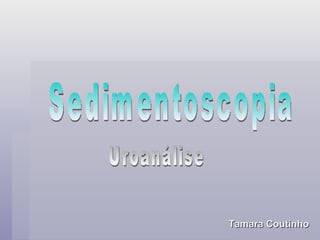
Atlas de uroanálise
- 1. Sedimentoscopia Uroanálise Tamara Coutinho
- 3. Hemácias
- 5. Leucócitos Aglomerado de leucócitos
- 9. Células
- 13. Extrema estase do fluxo urinário Formação nos ductos coletores ou em túbulo distais distendidos Largo Síndrome nefrótica Lipidúria Corpos adiposos ovais Adiposo Estase do fluxo urinário Cilindros hialinos e granulares Céreo Glomerulonefrite Pielonefrite Estresse e exercício físico Desintegração de cilindros leucocitários Lisossomos das células tubulares Agregados protéicos Granular Lesão de túbulo renal Células tubulares que permanecem ligadas às fibrilas da proteína de Tamm-Horsfall Epiteliais Pielonefrite Bactérias presas à matriz da proteína de Tamm-Horsfall Bacterianos Pielonefrite Nefrite intersticial aguda Leucócitos emaranhados ou ligadas à matriz das proteínas de Tamm-Horsfall Leucocitário Glomerulonefrite Exercício físico intenso Hemácias emaranhadas ou ligadas à matriz das proteínas de Tamm-Horsfall Hemático Gromerulonefrite Pielonefrite Doença renal crônica Insuficiência cardíaca congestiva Estresse e exercicio físico Normal 0-2/cpa Secreção tubular de proteína de Tamm-Horsfall que se agrega as fibrilas Hialino Significado clínico Origem Tipo
- 15. Cilindro Hialino
- 28. Cilindro Céreo
- 31. Diversos cilindros A. hialino B. hemático C. hemático D. epitelial E. leucocitário F. hemático G. granular H. granular I. céreo
- 33. Principais Características dos Cristais Urinários Normais Gás do ácido acético Incolor (halteres) Alcalino Carbonato de cálcio Ácido acético com calor Marrom-amarelado (maçãs espinhosas) Alcalino Biurato de amônio Ácido acético diluído Incolor (tampa de caixão) Alcalino Fosfato tripo Ácido acético diluído Incolor Alcalino Neutro Fosfato de cálcio Ácido acético diluído Branco-incolor Alcalino Neutro Fosfatos amorfos HCL diluído Incolor (envelope) Ácido/neutro (alcalino) Oxalato de cálcio Álcalis e calor Cor de tijolo ou marrom-amarelado Ácido Uratos amorfos Álcalis Marrom-amarelado Ácido Ácido úrico Aparência Solubilidade Cor pH Cristal
- 34. Principais Características dos Cristais Urinários Normais Em refrigeração, forma feixes Incolor Ácido/neutro Ampicilina 10% de NaOH Incolor Ácido Corante radiográfico Acetona Verde Ácido/neutro Sulfonamidas Ácido acético, HCL, NaOH, éter, clorofórmio Amarela Ácido Bilirrubina Álcali ou calor Incolor/amarela Ácido/neutro Tirosina Álcali quente ou álcool Amarela Ácido/neutro Leucina Clorofórmio Incolor (placas chanfradas) Ácido Colesterol Amônia, HCL diluído Incolor Ácido Cistina Aparência Solubilidade Cor pH Cristal
- 36. Cristais Biurato de Amônio
- 38. Cristais de Ácido Úrico
- 39. Cristais de Ácido Úrico
- 42. Cristal de Fosfato Triplo
- 43. Cristais de Fosfato de Amônio e Magnésio Cristalizado
- 46. Cistina
- 48. Cristais
- 51. A represents the residue of normal human urine, as seen under the microscope. In division B is represented oxalate of urea . An excess of this element indicates indigestion, and is also characteristic of a plethoric, or full habit of the body. Nitrate of urea is represented in division C. A deficiency of urea in the renal secretion is a certain indication of anæmia. In Fig. 2 (divisions A and B), highly magnified urinary deposits, which indicate different degrees of impairment of the digestive functions are represented. The crystals seen in division C indicate the same debility accompanied with derangement of the mental faculties. Those in divisions D and E indicate still more aggravated forms of the same disorder.
- 52. In division A is represented pus and mucus, the presence of which indicates suppuration of the kidneys (Bright's disease). In B pus globules are alone represented. In the division marked C are shown blood corpuscles as they are arranged in blood drawn from a vein or artery. D represents the same separated, as they always are when present in the urine. In E highly magnified oil globules are represented. If present in the urine, they indicate disease of the kidneys. In the division marked F are represented epithelial cells, the presnce of which in large numbers is indicative of diseaes of the mucous lining of the urinary organs. In division A are presented urinary crystals, which indicate an irritable state of the nervous system. The crystals shown in division B are of the same character as the preceding, but bear evidence of greater mental debility. In division C are represented crystalling deposits indicating malassimilation of food and a tendency to hypochondria. Division D contains a representation of the mixed phosphates. They are indicative of severe diseases attended with hypochondria and general nervous prostration.
- 53. In division A are represented the mixed urates as they appear durin idiopathic fevers, as intermittent, remittent, etc. When appearing as seen in division B, a less violent affection of the same character is indicated. Division C represents urate of ammonia, occasionally observed when there is a tendency towards albuminuria, or dropsy, resulting from granular degeneration of the kidneys, as in incipient Bright's disease. In division D is represented urate of soda, which is present in the urine of persons suffering from gout. The crystals shown in division E consist of the same salt. In division A, Fig. 6, is represented purulent matter as it appears in the urine. The absorption of pus from abscesses in different parts of the system is frequently followed by the appearance of pus globules in the urine. When fat globules, represented in division B, are found in the urine, they indicate fatty degeneration. In division C are representations of the cells found in the urine of persons suffering from consumption or other scrofulous diseases.
- 54. In division A, Fig. 8, are represented the caudated cells characteristic of hard cancer. The cells represented in division B are concentric, and characteristic of the soft varieties of cancer. Fig. 7 represents the different forms of cystine found in the urine of scrofulous and consumptive persons. In division A it is represented as seen in an amorphous (non-crystallized) form, and in B it appears in crystals. In division C is a representation of the deposits seen in the urine of those who are greatly debilitated. In division D are seen epithelial cells mixed with mucus.